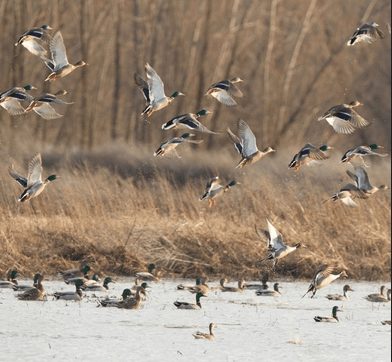OVERTIME OUTDOORS:As duck season winds to a close, January numbers exceed December
Published 6:00 am Tuesday, January 30, 2024

- More ducks were counted in Louisiana in January, according to the Louisiana Department of Wildlife and Fisheries. Biologists led by LDWF waterfowl program manager Jason Olszak conducted their monthly aerial waterfowl population survey over several days and counted an estimated 1 1/2 million ducks in the Sportman's Paradise.
Nearly 1 ½ million ducks were in coastal Louisiana and the Little River Basin in early January, so it’s highly probable duck hunters saw more of them during the stretch run of the season.
Louisiana Department of Wildlife and Fisheries waterfowl program manager Jason Olszak and his staff conducted their aerial waterfowl population survey Jan. 3, 4, 11. January’s weather definitely challenged the biologists taking their monthly survey.
“Weather delays, in addition to January holidays and additional state office closures, prevented the entirety of the survey from being completed in a short time frame as desired,” Olszak wrote in his report. “The extra days devoted to surveying waterfowl in northwest Louisiana and geese in the coastal region were not possible until Jan. 17-19.”
There were an estimated 1.47 million ducks in the state, a 72-percent increase from December’s record low of 853,000 ducks, Olszak reported in a prepared statement released Jan. 24. Every species but shovelers increased from their December estimates.
Olszak noted increases from December to January in canvasback, 7,000 to 52,000 (643-percent); wigeon, 4,000 to 21,000 (425-percent); scaup, 41,000 to 179,000 (337-percent); mallards, 11,000 to 28,000 (118-percent); green-winged teal, 151,000 to 287,000 (90-percent), and gadwall, 184,000 to 326,000 (77-percent).
As rosy as those numbers might seem, the overall count is the lowest January estimate on record and 26-percent lower than January 2023, when there were 1.99 million ducks in the Sportsman’s Paradise, the veteran waterfowl biologist reported. The January estimate also is 50-percent below the long-term average of 2.96 million, 34-percent below the most recent 10-year average and 41-percent under the most recent 20-year average.
Also, scaup, wigeon and mottled duck were the only three species showing increases this month over January 2023, according to Olszak. Scaup numbers jumped 397-percent, wigeon numbers went up 133-percent and mottled duck numbers rose 47-percent, according to the report.
The 2023-24 season closed Jan. 21 in the West Zone and closes Feb. 3 in the East Zone.
The latest aerial waterfowl population survey shows a significant increase of ducks in southwest Louisiana, where most of us hunt. Southwest Louisiana’s estimate of 716,000 ducks was 56-percent higher than the December estimate of 458,000 but 42-percent lower than last January’s estimate of 1.23 million and 39- and 46-percent lower than the most recent 5-year and 10-year January averages, respectively, for the region.
This region’s coastal marsh’s estimated numbers were lower than the southeast region’s coastal marsh’s estimated numbers for the first time since 2015.
On a positive note, water levels in southwest Louisiana marshes returned to near-normal levels in some areas, Olszak noted, but still were below average overall.
“Poor production through late summer of both submerged aquatic and emergent vegetation remained apparent and likely reduced the carrying capacity of these marshes considerably, especially late into winter. Similar to December, nearly 50- to 75-percent of agricultural fields capable of holding water were inundated both above and below I-10,” Olszak wrote in the report.
Just like in January 2023, ducks were distributed longitudinally with the largest flocks observed in the brackish and intermediate marsh south of the Gulf Intracoastal Waterway. The black-bellied whistling duck estimate for the region was 145,000 with the majority counted south of Lake Arthur with smaller flocks south of Pecan Island and Abbeville.
As for the region’s goose numbers, the biologists made a concerted effort for a mid-winter count across the state. In southwest Louisiana that included the area north of that covered by the traditional coastal transects, which are 10 miles apart horizontally and north from I-10 to the Gulf Coast starting southeast below Lafayette west to near the Louisiana-Texas state line.
“Non-forested habitats in the area between the towns of Vinton, Bunkie and St. Martinville were surveyed for geese via a cruise survey. In total, 162,000 light geese (snow geese and Ross’ geese) and 19,000 white-fronted geese were counted in southwest Louisiana. The largest flocks were observed sporadically in agricultural fields between Bell Cityand Kaplan, Eunice, Bunkie and Port Barre, and on Marsh Island Refuge,” Olszak said in the report.
DON SHOOPMAN is outdoors editor of The Daily Iberian.





